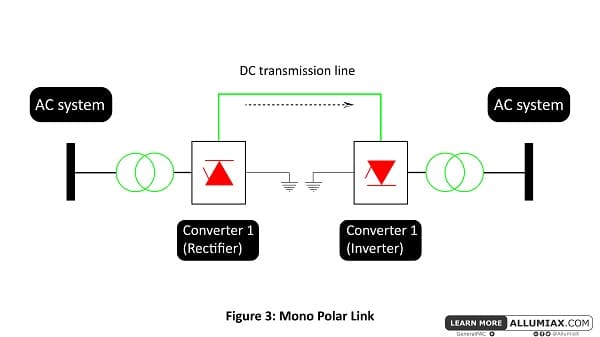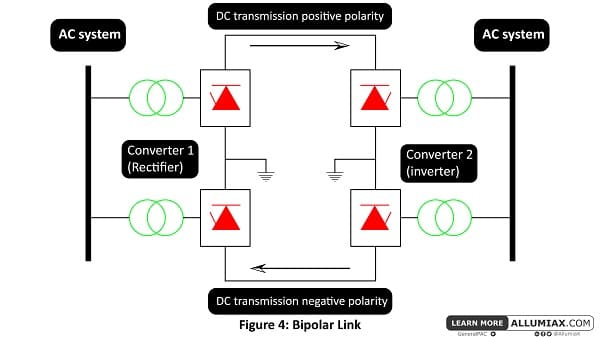High Voltage Direct Current HVDC Transmission

Definition: High Voltage Direct Current transmission, abbreviated as HVDC is a bulk power transfer technology using Direct current for transmission of electricity, in contrast to HVAC power systems which operate on Alternating current. Superhighway or Power Superhighway is the electrical name that is often used for HVDC.
In AC Transmission, direction of voltage and current changes continuously which causes overheating in the lines, thus resulting in significant power loss. Unlike AC transmission, current and voltage flow in one direction only in DC Transmission. So, when we convert HVAC into HVDC we observe significant reduction in power loss hence increasing the efficiency of the transmission lines.
HVDC Transmission system is the combination AC and DC system, first the generated AC voltage is converted into DC at the transmission end, when it reaches the receiving end DC is inverted to AC for distribution purposes. So, in order to carry out this operating, we need conversion devices at both ends of transmission line. However, HVDC Transmission is economical only for long distance transmission; overhead lines having a length more than 600km and underground cables of length more than 50km. Further we are going to discuss components, working, classification, comparison with HVAC system, advantages & disadvantages of a HVDC Transmission system.
Components of HVDC System
Converter:
Converts AC to DC and DC to AC. It consists of rectifiers and inverters.
Rectifier:
A device that converts alternating current to direct current which flows only in one direction.
Inverter:
A device that converts direct current into alternating current.
Electrodes:
Conductors that are used to connect the system to the earth.
Smoothing Reactors:
Smoothing reactors consist of inductors connected in series with the pole of each converter station. It prevents commutation failures experienced by inverters, reduces harmonics, and avoids breaking off the current.
DC Lines:
Cables or overhead lines that carry power.
Harmonic Filters:
Used to minimize the harmonics in voltage and currents of the converters used.
Reactive Power Supplies:
Converters at the terminals consume reactive power from the supply, thus shunt capacitors are used to provide this reactive power compensation.
AC Circuit Breaker:
Used for electrical safety ; like fault in transformers, disconnection of the DC link.
How does HVDC Transmission System Work?
In generating substation, AC power is generated, which is converted into DC using a rectifier. The DC flows through the overhead line, and then again at the user end, DC is converted into AC using inverters and then AC is supplied to the load. Rectifiers and inverters are placed inside the converter stations at the sending and receiving ends.
As DC flows through overhead lines, the input power is equal to the output power, decreasing the losses and improving efficiency.
The diagram above shows two converter stations and one transmission line, so this type of system is known as the 'Point-to-point system' or 'Two terminal DC system.' Likewise, if there are more than two converters and the interconnecting DC terminal lines in a substation, it is named 'Multi terminal DC substation.'
HVDC Links Types
HVDC links are used for connecting two networks or a system. They are classified into three types:
Monopolar Link:
Mono means '1', so It has only one conductor of negative polarity, and return path is provided by earth and sea. Operation with negative polarity with respect to the ground reduces the corona loss and radio interference in the line. Monopolar links consist of two converters placed at the end of each pole along with earth electrodes attached to the converters. They are placed approximately 15 to 55km away from respective terminal stations. Monopolar HVDC links were used only for low power rating and mainly for cable transmission, but it is not often used now because of several disadvantages.
Bipolar Link:
Bi means '2', so bipolar link has two conductors one is positive, and one is negative to the earth. It also consists of a converter station at each end and electrodes connected at the midpoints of the converter station for earthing, allowing each pole to operate independently. Moreover, if any of the bipolar links stops working, the link automatically converts to monopolar mode because of the ground return system; as a result, half of the system continues to supply the power. Bipolar link is widely used in long-distance HVDC transmission.
Homopolar Link:
A homopolar link consists of two conductors of the same polarity usually negative, and always uses the earth as the return conductor. As the poles in this link are operated in parallel, it reduces the installation cost. This type of link has limited applications and is very complicated. Thus it is not currently used.
Comparison of HVDC and HVAC Transmission
| High Voltage Direct Current (HVDC) Transmission | High Voltage Alternating Current (HVAC) Transmission |
| Losses are quite low | Losses are high due to corona discharge and skin effect |
| More power is transmitted over long distances | Less power is transmitted |
| Voltage regulation and control ability is high | Low voltage regulation and control ability |
| It has fewer conductors hence line cost decreases | High line cost |
| Towers are simple and cheaper | Huge towers as compared to HVDC |
| It needs less Insulation | Requires more insulation |
| High reliability | Reliability is low |
| Asynchronous interconnection can be done | Asynchronous interconnection is not possible |
This graph shows the comparison between cost of AC and DC Transmission with respect to the distance. According to the graph, initial cost of HVDC transmission is high as compared to the HVAC Transmission due to a significant difference between DC and AC terminal cost (converter stations at terminals of HVDC Transmission system are very costly). However, at a specific distance cost of HVDC Transmission is equal to the cost of HVAC system, that point is called breakeven distance. After this point, overall cost of HVDC Transmission becomes low than HVAC Transmission (there are huge power losses in HVAC Transmission for long distances), hence proving the fact that HVDC Transmission system is economical for long distance transmission. The breakeven distance is around 600km for overhead transmission lines.
Advantages & Disadvantages of HVDC Transmissions
Advantages: This transmission requires fewer conductors and insulators, thus reduces the cost of the overall system. It requires less phase to phase and ground to ground clearance. Towers of HVDC transmission are inexpensive. Corona loss in HVDC transmission is lesser compared to the loss in power transmission lines of HVAC. Fewer lines are used for transmission of power. Therefore power loss is reduced. The HVDC system uses earth return in case of a fault in one pole. The pole with ‘earth returns’ behaves like an independent circuit, hence enhancing the system's flexibility. HVDC system is used to interconnect two substations with different frequencies. It has an asynchronous connection between two AC stations connected using the HVDC link; thus the transmission of power is independent of sending and receiving end frequencies. Proximity and skin effect do not transpire in the system due to the absence of frequency in HVDC lines. Reactive power compensation is not needed as there is no generation or absorption of any reactive power. Power flowing through DC link is very précised and lossless.
Disadvantages: Due to installation of converter substation at both the ends, conversion from AC to DC and vice versa becomes quite expensive. Harmonics are produced by rectifiers and inverters which are reduced by using active filters, hence cost of system is increased. HVDC substation has a chance of power failure if a fault occurs in the nearby AC substation. The overload capacity of inverters used in converter substations is restricted. The circuit breakers used in HVDC are very costly. Transformers are unavailable for changing the voltage levels. Heat loss occurs in converter substations. HVDC link itself is also very complicated.
Is HVDC better than HVAC?
Considering the advantages of HVDC transmission system we can say that it is more economical to use HVDC then HVAC but there are few disadvantages that we should consider like the initial cost of HVDC substation is quite high and the substation is very complicated. Hence, it concludes that HVDC system is preferred over HVAC system over long distance only in which power is generated in AC and then for transmission it is converted into DC, at the receiving end again it is converted back to AC for final use. Thus, we can make transmission system more economical along with improving its efficiency.

Stay Sharp & Join our Mailing List!
Subscribe to Allumiax Blog for updates on power system studies, tips, guides and insights on electrical engineering from industry leaders.










